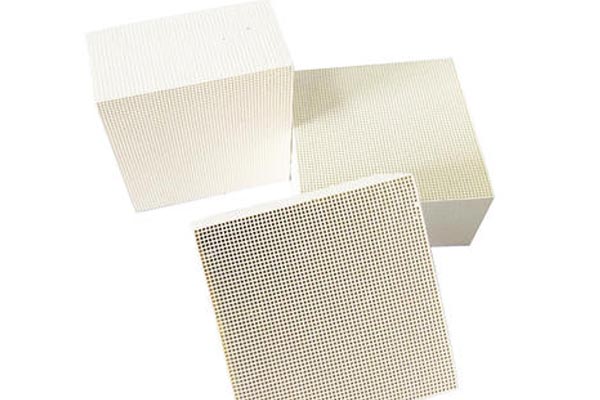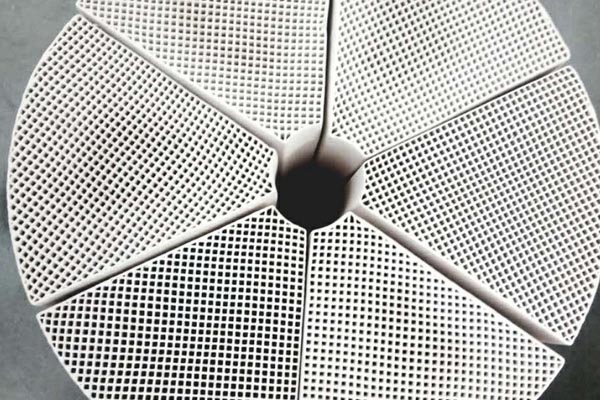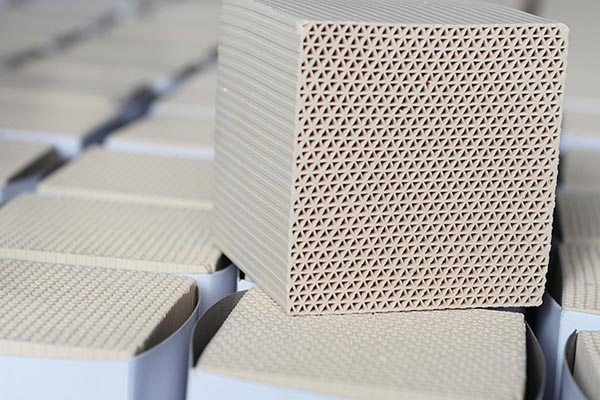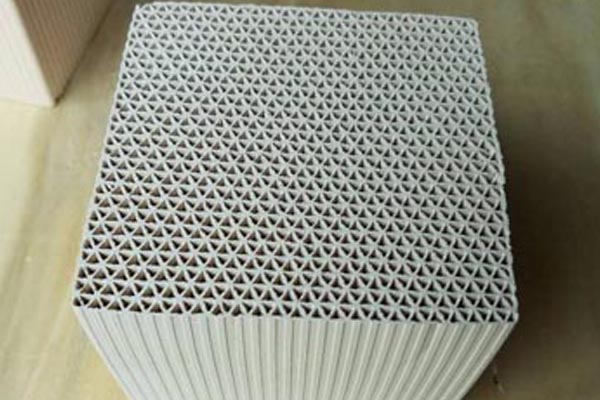
The main components of zeolite are: silicon and aluminum, which have adsorption capacity and can be used as adsorbent; Zeolite runner is to use the specific pore size of zeolite to have the ability of adsorption and desorption for organic pollutants, so that VOCs waste gas with low concentration and large air volume can be concentrated and converted into low air volume and high concentration gas by the zeolite runner, which can reduce the operating cost of the back-end final treatment equipment. Honeycomb zeolite molecular sieve Shangrao The characteristics of the device are suitable for treating waste gas with large flow, low concentration and various organic components. The disadvantage is high initial investment. The zeolite wheel adsorption purification device is a gas purification device that can continuously perform adsorption and desorption operations. The two sides of the zeolite runner are divided into three areas by special sealing devices: adsorption area, desorption (regeneration) area and cooling area. Honeycomb zeolite molecular sieve purchase The working process of the system is as follows: the zeolite runner rotates continuously at a low speed and circulates through the adsorption area, desorption (regeneration) area and cooling area; When the exhaust gas with low concentration and large air volume continuously passes through the adsorption area of the runner, VOCs in the exhaust gas are adsorbed by the zeolite of the runner, and the gas purified by adsorption is directly discharged; The organic solvent adsorbed by the wheel is sent to the desorption (regeneration) area with the rotation of the runner, and then the small amount of hot air continuously passes through the desorption area. The VOCs adsorbed on the runner are thermally desorbed in the desorption area to achieve regeneration, and the VOCs waste gas is discharged together with the hot air; After the runner is transferred to the cooling area for cooling, the adsorption can be carried out again. With the continuous rotation of the runner, the adsorption, desorption and cooling cycles are carried out to ensure the continuous and stable operation of waste gas treatment.

Molecular sieve has clear pore cavity distribution, extremely high internal surface area (600m2/s), good thermal stability (1000 ℃), and adjustable acid site center. The acidity of molecular sieve mainly comes from three coordinated aluminum atoms and aluminum ions (AlO)+on the framework and in the pores. OH based acid sensitive site center on molecular sieve HY obtained by ion exchange, Honeycomb zeolite molecular sieve Shangrao The aluminum ions outside the framework will strengthen the acid site and form the L acid site center. Polyvalent cations such as Ca2+, Mg2+and La3+can show the acid site center after exchange. The reduction of transition metal ions such as Cu2+and Ag+can also form acid site centers. In general, the higher the Al/Si ratio, the higher the specific activity of OH group. The modification of zeolite acidity can introduce protons through direct exchange of dilute hydrochloric acid. This method often leads to dealumination of molecular sieve framework. So NaY will become NH4Y and then HY. Because there are uniform small internal pores in the structure of molecular sieves, when the molecular linearity of reactants and products is close to the pore size in the crystal, the selectivity of catalytic reaction often depends on the corresponding size of molecules and pore size. Honeycomb zeolite molecular sieve purchase This selectivity is called shape selective catalysis. There are two mechanisms leading to shape selectivity. One is caused by the difference of diffusion coefficient of molecules participating in the reaction in the pore cavity, which is called mass transfer selectivity; The other is caused by the space limitation of the transition state of the catalytic reaction, which is called transition state selectivity.

The main material of honeycomb zeolite adsorbent is natural zeolite. The zeolite manufacturer is an inorganic microporous material composed of sio2, al_2o_3 and alkaline metal or alkaline earth metal, Honeycomb zeolite molecular sieve purchase Its inner pore volume accounts for 40-50% of the total volume, and its specific surface area is 100-500 m2/g. It is characterized by high temperature resistance, non flammability, good thermal stability and hydrothermal stability. It is an efficient molecular sieve carrier with good adsorption performance, no secondary pollution, and can be regenerated at high temperature. Compared with honeycomb activated carbon, its performance is about 25% of its efficiency, but it has high temperature resistance and is not easy to ignite Catalysis and environment are widely used, which is more suitable for the treatment of organic waste gas with large air volume and low concentration. Zeolite adsorbent products include microporous adsorbent and mesoporous adsorbent. Honeycomb zeolite molecular sieve manufactor (1) Microporous molecular sieves with molecular apertures below 2 nm, mesoporous molecular sieves with molecular apertures above 50 nm (macroporous molecular sieves with molecular apertures above 50 nm), mesoporous molecular sieves have high specific surface area, regular and orderly pore structure, narrow pore size distribution, continuous and adjustable pore size and other characteristics, which make it difficult to complete the adsorption and separation of macromolecules in many microporous molecular sieves, And catalytic reaction. (2) Therefore, molecular sieve materials with different properties and pore sizes shall be configured according to the different components of organic waste gas during selection, so as to achieve targeted organic waste gas treatment, meet the design requirements and emission standards.

Honeycomb zeolite molecular sieve has the crystal structure and characteristics, the surface is a solid skeleton, and the internal holes can play the role of adsorption molecules. There are channels between the holes to connect with each other, and molecules pass through the channels. Due to the crystalline nature of the pores, the pore size distribution of the molecular sieve is very uniform. Molecular sieves selectively adsorb molecules according to the size of holes in their crystals, that is, they adsorb molecules of a certain size and repel molecules of larger substances, so they are vividly called "molecular sieves". The adsorption or repulsion function of molecular sieves is affected by the molecular electricity. Synthetic zeolite has the special function of selective adsorption according to molecular size and polarity, Honeycomb zeolite molecular sieve manufactor Therefore, gas or liquid can be dried or purified, which is also the basis for molecular sieve separation. Synthetic zeolite can meet the extensive demand of industry for adsorption and selective products, Shangrao Honeycomb zeolite molecular sieve It is also widely used in industrial separation to synthesize zeolite molecular sieves. Advantages of UOP molecular sieve

Molecular sieve is a crystalline silicate or aluminosilicate, which is a pore and cavity system with molecular size (usually 0.3nm to 2.0nm) formed by connecting silicon oxygen tetrahedron or aluminum oxide tetrahedron through oxygen bridge bond, Honeycomb zeolite molecular sieve Shangrao Therefore, it has the characteristics of screening molecules. However, with the deepening of molecular sieve synthesis and application research, researchers have found phosphoaluminate molecular sieves, and the skeleton elements (silicon or aluminum or phosphorus) of molecular sieves can also be replaced by B, Ga, Fe, Cr, Ge, Ti, V, Mn, Co, Zn, Be and Cu, and the size of its pores and cavities can also reach more than 2 nm, Honeycomb zeolite molecular sieve purchase Therefore, molecular sieves can be divided into silicon aluminum molecular sieves, phosphorus aluminum molecular sieves and skeleton heteroatom molecular sieves according to the composition of skeleton elements;

Honeycomb zeolite molecular sieve purchase Microporous molecular sieves with molecular apertures below 2 nm, mesoporous molecular sieves with molecular apertures above 50 nm (macroporous molecular sieves with molecular apertures above 50 nm), mesoporous molecular sieves have high specific surface area, regular and orderly pore structure, narrow pore size distribution, continuous and adjustable pore size and other characteristics, which make it difficult to complete the adsorption and separation of macromolecules in many microporous molecular sieves, And catalytic reaction. Therefore, molecular sieve materials with different properties and pore sizes shall be configured according to the different components of organic waste gas during selection, so as to achieve targeted organic waste gas treatment, meet the design requirements and emission standards. The main material of honeycomb zeolite adsorbent is natural zeolite. The manufacturer of zeolite is composed of silica Inorganic microporous material composed of al_2o_3 and alkaline metal or alkaline earth metal, with inner pore volume accounting for 40-50% of the total volume and specific surface area of 100-500 m2/g, has the characteristics of high temperature resistance, non flammability, good thermal stability and hydrothermal stability. It is an efficient molecular sieve carrier with good adsorption performance, no secondary pollution, and high temperature regeneration. Compared with honeycomb activated carbon, its performance is about 25% of its efficiency Honeycomb zeolite molecular sieve Shangrao However, it is widely used in the fields of adsorption, separation, catalysis and environment due to its high temperature resistance and low ignition resistance. It is more suitable for the treatment of organic waste gas with large air volume and low concentration.





